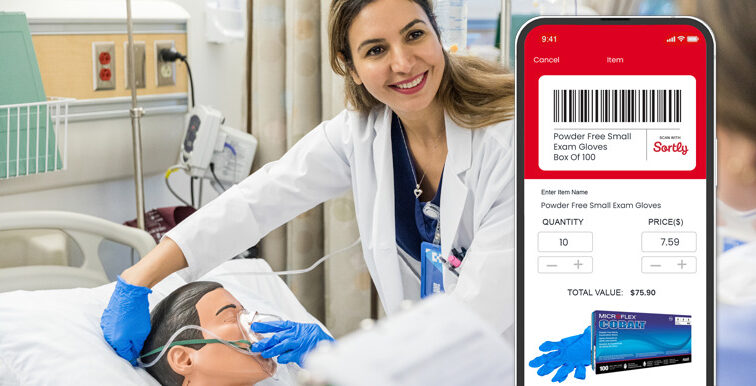Inventory efficiency is more important than ever in higher education. Colleges and universities are facing increasing pressure to reduce costs and improve efficiency, while also maintaining high standards of education and research. One way to achieve these goals is to leverage new and emerging technologies in the area of inventory management.
Improving inventory management with technology is a logical choice for education; as many institutions of higher learning make it their mission to find solutions to complex problems and rethink old paradigms. Traditionally, inventory management in education has been a manual process, involving spreadsheets, paper records, and a lot of time and effort. However, new and emerging technologies are now offering more efficient and effective ways to manage inventory.
Let’s start by exploring the inventory challenges in the industry and why technology solutions are needed.
Inventory management challenges in higher education
Colleges and universities face unique challenges when it comes to managing inventory. They are often large and complex organizations, with multiple schools, campuses, and departments. This siloed structure and lack of visibility between departments can make it difficult to track and manage inventory across the entire institution.
Additionally, each department tracks very different types of inventory, which means they have unique needs when it comes to an inventory system. Different schools, campuses, and departments may have different inventory procedures, systems, and vendors. This can make it difficult to get a complete and accurate view of inventory levels across the board.
In 2021, Mercy University’s School of Nursing was struggling with many of these issues. “We were using spreadsheets to track inventory across two different campuses, which was quickly becoming unsustainable,” said Damien Germino, Director of Finance and Operations for the School of Nursing. “We needed a solution that would improve visibility between our two campuses and proactively remind us to reorder inventory to avoid overspending. We also needed it to be simple enough for our entire staff to use, including our student assistants. When we adopted Sortly for PPE consumables management, we were pleasantly surprised at how easy it was to transform our inventory processes. It allowed us to switch to tracking inventory on our smartphones, eliminating our reliance on outdated technology. Helpful automation features like low stock alerts and barcoding helped us drive efficiency, track inventory more accurately, and future-proof our department’s inventory processes.”
With that in mind, let’s take a closer look at some of the inventory trends we see on the horizon in education inventory management and how these emerging technologies can help higher education institutions transform their inventory processes.

Trend #1: Mobile inventory management
Mobile inventory management is the use of smartphones and tablets to track inventory levels and locations in real time. Mobile inventory tracking is increasingly common for many types of businesses, and we predict it will continue to gain traction in education as an alternative to manual inventory processes.
Mobile inventory management offers a number of clear benefits. It enables teams to track inventory right from their smartphones and update inventory from anywhere—making it ideal for busy campuses with multiple locations. Mobile inventory solutions offer real-time tracking, unlike spreadsheets. This means that inventory quantities and locations are always accurate, allowing users to make informed decisions quickly.
Mobile inventory management helps drive efficiency, which is critical in education. Automating tasks such as inventory cycle counting and even order placement with a mobile solution helps optimize inventory levels—and frees up staff to focus on other pressing responsibilities. It can also help reduce errors by eliminating the need for manual data entry.
Mobile inventory solutions like Sortly are also still evolving to meet the needs of busy professionals, including those within higher education. In the future, time-saving features like widgets may become more common, allowing users to view stock levels at a glance and make updates quicker without having to search within the app. We predict mobile solutions will continue to shift towards automation, making them increasingly appealing for busy departments with complex inventory needs.
Trend #2: Visual inventory tracking
Broadly speaking, visual inventory tracking refers to tracking inventory through the use of photos. This trend is becoming increasingly popular, as certain inventory solutions allow users to add inventory photos, enabling them to see the exact item and the condition it’s in. We anticipate that visual inventory tracking will become more widely used in colleges and universities as they continue to adapt digital inventory solutions.
Visual inventory tracking is a particularly good fit for education, as many colleges and universities track reusable assets, equipment, machinery, and so on. Visual inventory tracking solutions can be used to track the condition of assets over time. This is important for high-value assets that might be used in a scientific, clinical, or even studio setting, such as microscopes, blood pressure machines, and 3D printers. For instance, each member of a department would simply snap and upload a photo after each use, effectively documenting who used what, when, and how they left it.
Visual inventory tracking is useful for tracking different item variants, such as different sizes, colors, or manufacturers. This is especially useful for tracking inventory in campus laboratories and other specialized settings with many supply variants (for instance, different sizes of needles or syringes at a medical school, or different types of envelopes in an administration office). Being able to visually identify the right item helps the whole team keep accurate inventory and avoid over or under-ordering new supplies.
As inventory solutions become even more sophisticated, we anticipate visual inventory tracking to go beyond photos and incorporate the digital visualization of a physical space. Visual inventory management at colleges and universities will become more immersive than just photos; imagine augmented reality and VR leveraged for visual inventory recording. Rather than just look at photos of their items, users would be able to virtually explore inventory storage zones and placements in real time, similar to how Google Street View works—simply hold your phone up and see where items are as you pan across the space. This technology is convenient for many industries, but especially higher education where inventory is often spread out across campuses and physical storage varies by the needs of each department.

Trend #3: Automation
Automation is the use of software to automate inventory tasks in order to save time and improve accuracy. Although automation features vary widely, they all have the same goal: making inventory processes smarter and less manual. For instance, barcoding inventory is a type of automation because it speeds up receiving and/or searching for inventory. Alerts are another type of automation—your inventory solution reminds you to reorder inventory (or even does it for you) to make the process more automatic.
Inventory management can be so much more than a record of inventory; it can be a tool that automates the flow of inventory through your organization. Automating inventory processes like re-ordering, cycle counting, and receiving is key to reducing costs and improving efficiency. But beyond saving time and money, inventory automation can free up staff to focus on other vital tasks that more closely align with the mission of higher education. Your brightest minds should be focused on research, learning, and teaching—not manual data entry.
Mercy University’s School of Nursing, for example, has embraced automation and incorporates it into its everyday inventory processes. “We use QR codes to track consumable inventory such as lab gloves, sanitation supplies, and even PPE, which helps us make more rapid, real-time updates,” said Germino. “It also helps us better identify usage trends over time; by automating our inventory intakes with QR codes, we were able to observe that these items were being used faster than expected, especially during COVID and in simulation clinical learning experiences. We also use Sortly’s low stock alerts to remind us when we’re running low on medical supplies, which helps streamline and automate our weekly re-ordering. We’re optimistic that more colleges and universities will follow suit—and that inventory solutions will continue to evolve their automation features to even better serve the education industry.”
Experience the simplest inventory management software.
Are you ready to transform how your business does inventory?
Trend #4: Artificial intelligence (AI)
The rise of AI is undeniable; it is rapidly integrating into our personal and professional lives, and we anticipate it will soon influence how we manage inventory. Artificial intelligence (AI) is being used in inventory management to predict demand, optimize inventory levels, and automate tasks. AI is still in its nascent stages of development, but it has the potential to revolutionize the way that inventory is managed in higher education.
How might AI be used for inventory management in higher education? In the near future, AI-powered inventory solutions could actually predict demand using historical data and other factors. This information can then be used to optimize inventory levels and avoid stockouts. Tasks such as order placement and inventory forecasting could soon be the responsibility of AI, rather than the people using and managing the inventory.
Beyond the automation aspects of AI, it could also make navigating your inventory system even easier; rather than searching for an item, you could simply “ask” your inventory software where something is, or when the last time you re-ordered office supplies was. The use of natural language processing and AI could allow users to more easily query their inventory data and actually derive insights from conversations with a bot.
We’ve observed the rise of AI assistants and chat bots in other industries such as tech and healthcare, and we anticipate that higher education will follow suit as the technology becomes more readily available in digital inventory solutions.

Trend #5: Blockchain
Blockchain is a distributed ledger technology that can be used to track the movement of inventory through a supply chain. Blockchain is still in its early stages, but it has the potential to improve the transparency and traceability of inventory in higher education. Unlike the other inventory management trends we’ve covered, blockchain technology is focused on cybersecurity and digital record keeping—which is critical at colleges and universities.
For instance, schools could use blockchain to track the movement of laptops and other equipment from the manufacturer to the school district to the student. “ In a medical setting, such as the Mercy University School of Nursing, we can leverage RFID technology to tag clinical coats and scrubs for washing and swapping during simulations or use tokenized certificates during fit-testing to ensure there’s an immutable record of respirator fit,” said Germino. “The IoT (Internet of Things) can also help keep digital logs without needing any human oversight. For example, we might soon be able to track lab supplies as they move between rooms or buildings through the use of IoT sensors, rather than by inputting data.”
Blockchain-powered inventory solutions can help colleges and universities keep a tamper-proof record of all inventory transactions, reducing fraud and theft. They can also improve inventory management efficiency by further automating tasks, such as order placement and inventory forecasting. Importantly, they provide better data for decision-making by providing a complete and accurate record of all inventory transactions.
Conclusion
The five trends discussed in this article are just a few of the ways that technology is changing the way that inventory is managed in higher education. As technology continues to evolve, we can expect to see even more innovative and effective ways to manage inventory in the years to come.
Here are some things that education institutions can do to prepare for these trends:
- Invest in modern inventory management software that lets you customize a fully digital, mobile inventory system.
- Develop a plan for implementing new inventory management processes across all of your locations.
- Share inventory procedures across departments to help break down silos and increase visibility within your organization.
By taking these steps, education institutions can ensure that they are prepared to take advantage of the latest technology to improve their inventory management processes.
Would your school or department benefit from a smarter, more modern inventory solution? Learn how Sortly can help educational institutions transform their inventory processes.
About Mercy University

Mercy University is an independent, coeducational institution serving more than 9,000 students each year across campuses in Westchester, the Bronx, Manhattan, as well as online. It is a federally designated minority-serving institution and the largest private Hispanic Serving Institution in the state of New York. Mercy offers more than 100 undergraduate and graduate degree programs and certificate programs within six schools: Business, Education, Health and Natural Sciences, Liberal Arts, Nursing and Social and Behavioral Sciences. The institution also provides non-credit courses and certificates for adult learners looking to acquire new skills through CERTiFi by Mercy University. Mercy was founded in 1950 by the Sisters of Mercy whose mission of transformative education remains strong. For more information, visit www.mercy.edu.

